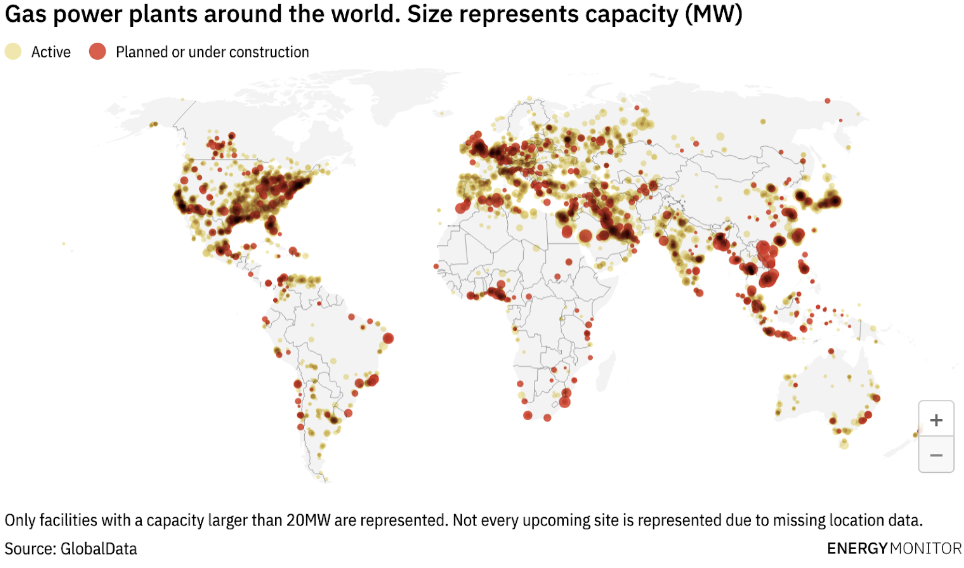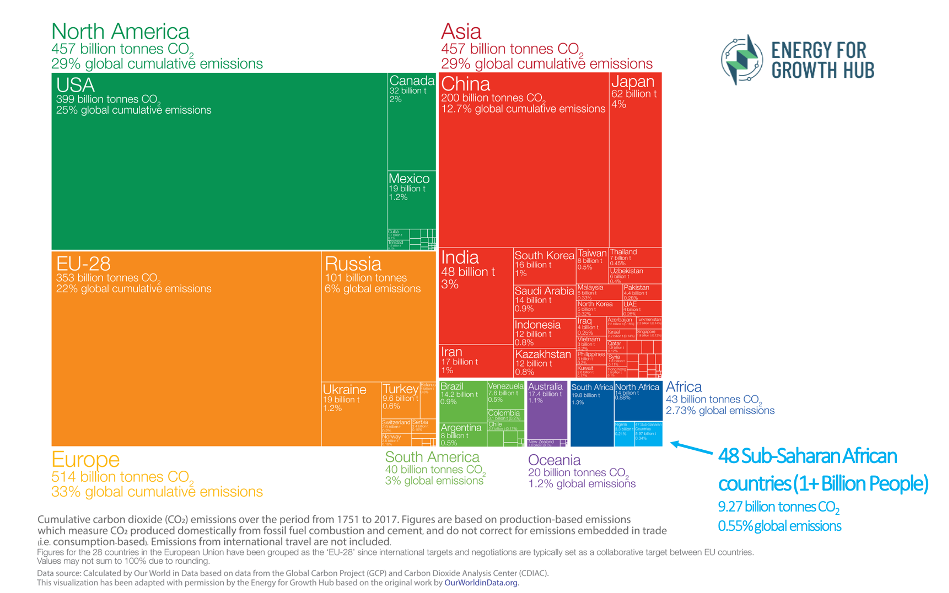Europe’s energy crisis is aggravating a decades-old tension between the developed and the developing world. As wealthy countries increase natural gas imports (including from Africa), many of them are maintaining policies that restrict development finance for gas-fired infrastructure projects in poorer nations. This hypocrisy is not lost on African leaders.
However, the debate surrounding this issue tends to reflect one of two extremes. On the one hand, advocates for continued gas financing argue that economic development should have greater priority than climate concerns and that natural gas projects should be freely funded in developing countries. On the other, those who oppose finance argue that a warming climate means there is simply no room for more emissions, including from Africa, and that investment in new gas-fired infrastructure would be both dangerous and unnecessary. Although some institutions (including the World Bank and the U.S. Government) have embraced a middle ground on paper, how such a compromise will be implemented in practice remains largely unclear. This analysis argues such a middle ground is not only possible, but imperative, and offers suggestions on how it can be implemented.
3 Reasons an African country might want to use gas
Reason 1: Gas is still an effective tool for human development.
Studies have shown connections between electricity access and multidimensional poverty. Increasing electricity access is therefore a focus of organizations such as The World Bank and countries themselves as one factor to strengthen development. In many areas of the world, natural gas is still a primary fuel for power generation and is sought-after in Africa as countries seek to rapidly expand reliable access to power. Natural gas can be used for baseload generation or as a dispatchable resource in partnership with renewables. Renewables such as solar and wind are variable and require backup generation or energy storage – natural gas is one resource that may be locally available, relatively inexpensive, and therefore able to fill this gap.
Not every country has access to gas, and some have access to vast hydropower or geothermal resources that can play a similar role, but for those where gas is the only viable option, using the resource for development can make sense. Currently, more than ten African nations, accounting for roughly half of the continent’s population, have meaningful access to the resource.
Reason 2: Gas could help reduce carbon emissions and air pollution.
Many African countries already have electrical grids dominated by renewable energy — for example Angola and Kenya use upwards of 70-90% (primarily hydropower and geothermal). However, because there is great unmet electricity demand, backup generator use is pervasive. In Sub-Saharan Africa (SSA), an estimated 6.5 million backup generators are in use, comprising 9% of total electricity consumed in the region and over 40% in western Africa. Many of these are small diesel generators that emit more CO2 emissions per kWh than natural gas and even more than coal plants (Figure 1). Just as important, these generators spew local air pollutants including particulate matter, sulfur dioxide (SO2), and nitrogen oxides (NOx) – generators alone contribute 15% of total NOx emissions in SSA. So even though many grids are quite “clean”, the unaccounted emissions and health costs of backup generation are extremely high. Adding natural gas generation to these grids would likely displace diesel generator use, decreasing total emissions. The Center for Global Development estimated that Nigeria alone could reduce its CO2 emissions by 63% if backup generators were replaced with electricity from natural gas plants. Methane leakage could potentially undercut the emissions benefits of switching diesel, heavy fuel oil (HFO), and coal to natural gas, so governments should take care to carefully regulate the industry to avoid this (more on this later).
FIGURE 1: Carbon dioxide emissions coefficients for diesel, gasoline, and natural gas. Data from EIA (2021).

Reason 3: Fairness. African gas has helped (and is still helping) make the developed world richer.
In 2019, less of Africa’s gas production was used for domestic power (35%) than was exported (40%), at least in part because of the lack of public international funding for gas-fired power plants on the continent. Forecasts are “showing the continent is on course to export 50% of its total gas output to Europe and Asia between now and 2025” in the wake of the Russia-Ukraine war. These gas exports provide energy in other countries, leaving African countries still in need of local electricity. A quick glance at a map of gas power plants around the world shows that gas-fired generation is mostly concentrated in wealthy countries (Figure 2). While the emissions from burning this gas are the same anywhere, rich countries are increasingly reaping the benefits.
FIGURE 2: Active, planned, and under-construction gas power plants. Figure from Energy Monitor.

In addition, emissions from Sub-Saharan Africa are historically negligible. Sub-Saharan Africa – excluding South Africa – has collectively emitted only half a percent of cumulative global CO2 emissions. In contrast, the United States, China, and the European Union developed primarily using fossil fuels, and have collectively contributed nearly 60% of these emissions. The United States, with just a third of the population of Sub-Saharan Africa, alone accounts for 25% (see Figure 3). This context makes low-income economies justifiably sensitive to OECD restrictions on funding for fossil fuels to support their own development. It would be unfair to restrict the use of gas in developing countries, while the developed world has benefitted, and continues to benefit, from the use of hydrocarbons.
FIGURE 3: Cumulative carbon dioxide emissions from 1751 to 2017. Figure from the Energy for Growth Hub.

How to build new gas-fired capacity while mitigating the risk of carbon lock-in
Just because gas development can make sense in many African countries does not mean it should be completely unregulated. Natural gas plants are designed to run for 25-30 years, raising concern among would-be donors about “carbon lock-in” in light of targets for net zero emissions by 2050. Countries seeking to develop gas can mitigate against carbon lock-in and emissions while pursuing development objectives by:
- Starting with the plant as a baseload source and then transitioning it to back-up generation. Combined cycle gas turbine plants (CCGTs), a type of gas plant that has been the principal design for new plants in the OECD for the last 20-30 years, can run efficiently in both baseload and peak modes. This is its main benefit over open cycle gas turbine plants, which although cheaper upfront, are much less efficient (and emit relatively more CO2) when heavily utilized. Thus, CCGTs can provide baseload energy supply in the near-to-medium term and then be used as a dispatchable energy source that will enable greater penetrations of solar and wind. Variable renewables need to be paired with storage or quickly dispatchable energy sources in order to provide reliable power, and gas is one option that uses local resources and is typically less expensive than others such as batteries.
- Reducing methane emissions through certified Responsibly Sourced Gas. Funders could insist on — and provide financial support for — measures to mitigate the methane emissions intensity of the natural gas-fired power plant fuel sources. Such measures can emulate established practices to produce so-called Responsibly Sourced Gas (RSG). In RSG, sensors and other measures are deployed to identify methane leaks and significantly reduce methane emissions. Some evaluations also include additional environmental and social impact standards. RSG has gained significant traction in the U.S., in part as foreign demand for RSG is growing, and nearly 20% of production is expected to be certified by the end of 2022. One evaluator of RSG – Project Canary – estimates that switching from gas with industry-average emissions intensity to RSG can lower emissions by up to 18%.
- Reducing emissions through other methods such as carbon capture, utilization, and storage (CCUS) – especially as the technology develops and decreases in cost – and blending and gradual substitution of natural gas with (green) hydrogen.
How the OECD would benefit from a more moderate gas policy
Beyond the economic opportunities of Western companies supporting gas and power-plant development, a more moderate gas policy and a fairer approach to African nations would confer intangible benefits. Recipient countries bristling at the hypocrisy of donor countries have said that climate finance, including funding for natural gas projects, is a key priority for the climate negotiations. Nigeria and Senegal have criticized the U.S. and Europe for their pledges to stop international natural gas funding. Such souring of attitudes and the deleterious effect on relationships can make it more challenging for the OECD to pursue other international initiatives (including, ironically, to address climate change). Specifically, it undermines the OECD countries’ efforts to stand up to China on the global stage, as evidenced by recent African voting in the U.N. supporting Chinese interests. The U.S. and Europe need to be seen as credible partners in order to build coalitions around their own priorities.
Thus, managed natural gas development gives OECD countries the opportunity to support emerging economy development, resolve a glaring source of friction with poorer countries, and create economic opportunities for themselves while fostering environmental and public health benefits. The OECD should take advantage of the COP27 to set a more constructive tone with the developing world and then the parties must get to work to lay out a framework and commitments of support.



